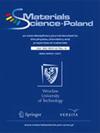纺织品升华印花:黑色印花织物的GLCM印花斑纹评价
IF 1.1
4区 材料科学
Q3 Engineering
引用次数: 0
摘要
采用升华印刷工艺,在不同的印刷温度和不同的印刷次数下,对白色织物进行了纯色调黑色的印刷,总油墨限制水平为100%。通过灰度共现矩阵(GLCM)图像处理方法确定印刷品斑纹,检测印刷品的非均匀性。用反射分光光度法测定印刷品的颜色强度。印花温度为190℃,印花时间延长为120 s,印花温度升高为210℃,印花时间缩短为60 s。斑纹较低的印本熵值、对比度和相关性最低,能量和均匀性最高。色彩强度越高,花纹斑纹越少。选择合适的印刷温度和印刷时间进行升华印刷,有助于实现低印刷斑驳和高色彩强度的印刷,并平衡成本,价格和价格。本文章由计算机程序翻译,如有差异,请以英文原文为准。
Textile Sublimation Printing: GLCM Print Mottle Assessment of Black Printed Fabric
The white fabric was printed with different printing temperatures and pressing times using the sublimation printing process in solid-tone black color with a 100 % total ink limiting level. Non-uniformity of the print was examined through print mottle determined by grey level co-occurrence matrix (GLCM) image processing method. Color strength of print was also determined by reflectance spectrophotometry. The print with the lower print mottle was obtained at a printing temperature of 190 °C at a longer pressing time of 120 s or at an increased printing temperature of up to 210 °C at the reduced pressing time of 60 s. The print with the lower print mottle had the lowest entropy, contrast, and correlation and the highest energy and homogeneity. The print with a higher color strength was accompanied by decreased print mottle. Choosing a suitable printing temperature and pressing time for sublimation printing is helpful in achieving print with low print mottle and high color strength and balancing cost, price, and price.
求助全文
通过发布文献求助,成功后即可免费获取论文全文。
去求助
来源期刊

Materials Science-Poland
工程技术-材料科学:综合
CiteScore
1.70
自引率
18.20%
发文量
0
审稿时长
6.2 months
期刊介绍:
Material Sciences-Poland is an interdisciplinary journal devoted to experimental research into results on the relationships between structure, processing, properties, technology, and uses of materials. Original research articles and review can be only submitted.
 求助内容:
求助内容: 应助结果提醒方式:
应助结果提醒方式:


